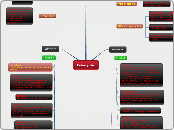Eukaryotic
ORGANELLES
Nucleus
Function: Directs cell activity
Endoplasmic Reticulum (ER)
Rough ER - Functions:
-Synthesis and modification of proteins.
-Synthesis of cell and organelle membranes.
Smooth ER - Functions:
-Lipid Synthesis
-Breakdown of toxic compounds
-Regulates sugar
-Calcium storage
Golgi Apparatus
Function: protein packaging factory.
Lysosomes
Functions:
-Molecular garbage dump and recycler of macromolecules
-Destruction of foreign material
-Digestion of food particles taken in by cell.
Vacuoles
Functions:
-Central vacuole: In plant cells. Store starch, water, pigments, poisons, and wastes.
-Contractile vacuole: Regulate water balance, by removing excess water from cell.
-Food or Digestion Vacuole: Engulf nutrients in many protozoa (protists).
Chloroplasts
Function: captures sunlight for
photosynthesis.
Mitochondria
Function: site of cellular respiration, produces ATP
Others organelles
Peroxisomes - Functions:
-Oxidation of organics substances
-Decompose H2O2 (catalase)
-Oxidize toxic substances
Chromoplast - Function: Synthesize and store pigments.
Centriole - Function: Help to organize the assembly of microtubules during cell division.
MEIOSIS
PHASES
Prophase I:
-Events similar to prophase of mitosis. The chromosomes coil up, the nuclear membrane disintegrate, and centrosomes moving apart.
-Synapsis (joining) of homologous chromosomes produce tetrads.
-The two chromosomes may exchange fragments by a process called crossing over.
Metaphase I:
-Bivalents (tetrads) aligned in the center of cell and attached to spindle fibers.
-The chromosome alignment illustrated from a cell with a diploid chromosome number of 8.
Anaphase I:
Separation of homologous chromosome
Telophase I:
-The nuclear envelope reforms
-Two cells formed
-Each cell is N with 4 chromosomes
-In the first meiotic division, the number of cells is doubled (one cell to two cells) and the number of chromosomes is reduced by half (8 to 4 with 8 chromatids)
Phases in Meiosis II – SIMILAR TO MITOSIS
The second meiotic division is like mitosis, the number of chromosomes does not get reduce (still 4 but single chromatid. As in mitosis, pairs of chromatids will form later)
STRUCTURES
Flagella and Cilia
Functions: for locomotion and movement substances along cell surface.
Cell membrane
Functions: Contain carbohydrates for cell recognition and serve as sites for bacterial attachment.
Contain sterols which increase resistance to osmotic lysis.
Cytoplasm
Functions: A complex network of thread jelly-like and tube-like structures, which provides support, shape, and movement.
-Microfilaments
-Intermediate filaments
-Microtubules
Ribosomes
Functions: site of protein synthesis (translation).
Found in all eukaryotic and prokaryotic cells.
Organelles
Functions: an organelle is a specialized subunit within a cell that has a specific function, and is usually separately enclosed within its own lipid bilayer.
MITOSIS
PHASES
Interphase:
Chromosomes not visible because they are uncoiled
Prophase:
-The chromosomes coil.
-The nuclear membrane disintegrates.
-Spindle fibers (microtubules) form.
A cell with 8 chromosomes. Each chromosome has 2 chromatids for a total 16 chromatids.
Metaphase:
The chromosomes become aligned.
Anaphase:
The chromatids separate, the number of chromosomes doubles.
A cell with 16 chromosomes. Each chromosome has 1 chromatid total is 16 chromatids
Telophase:
The cell divides into two.
The chromosomes uncoil.
The nucleus reforms.
The spindle apparatus disassembles.
G1 Interphase:
The chromosomes have 1 chromatid.
Two cells each cell has 8 chromosomes. Each chromosome has 1 chromatid for a total of 8 chromatids per cell.
G2 Interphase:
The chromosomes have two chromatids each.
The drawing shows two cells. Each cell has 8 chromosomes. Each chromosome has 2 chromatids for a total of 16 chromatids per cell.
